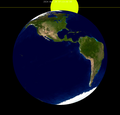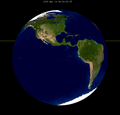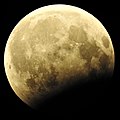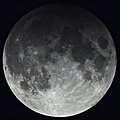March 2024 lunar eclipse
Appearance
| Penumbral eclipse | |||||||||
 From Richmond, Virginia, 7:18 UTC | |||||||||
| Date | 25 March 2024 | ||||||||
|---|---|---|---|---|---|---|---|---|---|
| Gamma | 1.0609 | ||||||||
| Magnitude | 0.9557 | ||||||||
| Saros cycle | 113 (64 of 71) | ||||||||
| Penumbral | 279 minutes, 9 seconds | ||||||||
| |||||||||
A penumbral lunar eclipse took place on Monday, March 25, 2024. It was visible to the naked eye as 95.57% of the Moon was immersed in Earth's penumbral shadow, making it the deepest penumbral eclipse overall since May 5, 2023, and the deepest for North and South America since February 11, 2017.[1]
Visibility
[edit]It was fully visible from most of the Americas, was rising over Australia and eastern Asia, and set over western parts of Africa and Europe.
Related eclipses
[edit]Eclipses of 2024
[edit]- A penumbral lunar eclipse on 25 March.
- A total solar eclipse on 8 April.
- A partial lunar eclipse on 18 September.
- An annular solar eclipse on 2 October.
Lunar year series
[edit]| Lunar eclipse series sets from 2024–2027 | ||||||||
|---|---|---|---|---|---|---|---|---|
| Descending node | Ascending node | |||||||
| Saros | Date | Type Viewing |
Gamma | Saros | Date Viewing |
Type Chart |
Gamma | |
113
|
2024 Mar 25
|
Penumbral
|
1.06098 | 118
|
2024 Sep 18
|
Partial
|
−0.97920 | |
| 123 | 2025 Mar 14
|
Total
|
0.34846 | 128 | 2025 Sep 07
|
Total
|
−0.27521 | |
| 133 | 2026 Mar 03
|
Total
|
−0.37651 | 138 | 2026 Aug 28
|
Partial
|
0.49644 | |
| 143 | 2027 Feb 20
|
Penumbral
|
−1.04803 | 148 | 2027 Aug 17
|
Penumbral
|
1.27974 | |
| Last set | 2023 May 05 | Last set | 2023 Oct 28 | |||||
| Next set | 2028 Jan 12 | Next set | 2027 Jul 18 | |||||
Saros series
[edit]It is part of Saros cycle 113.
Half-Saros cycle
[edit]A lunar eclipse will be preceded and followed by solar eclipses by 9 years and 5.5 days (a half saros).[2] This lunar eclipse is related to two total solar eclipses of Solar Saros 120.
| 20 March 2015 | 30 March 2033 |
|---|---|

|

|
Tritos series
[edit]- Preceded: Lunar eclipse of April 25, 2013
- Followed: Lunar eclipse of February 22, 2035
Tzolkinex
[edit]- Preceded: Lunar eclipse of February 11, 2017
- Followed: Lunar eclipse of May 7, 2031
See also
[edit]References
[edit]- ^ Hermit Eclipse: Saros cycle 113
- ^ Mathematical Astronomy Morsels, Jean Meeus, p.110, Chapter 18, The half-saros
External links
[edit]- Saros cycle 113
- 2024 Mar 25 chart: Eclipse Predictions by Fred Espenak, NASA/GSFC




